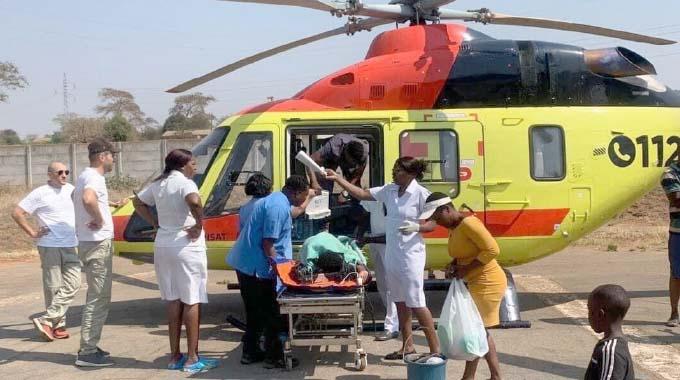News / National
Helidrive nears 500 airlifts
04 Jun 2025 at 09:44hrs | Views

HELIDRIVE National Air Rescue Service, a groundbreaking Zimbabwe-Russia emergency air ambulance initiative, has successfully airlifted 485 patients since its launch last year, offering a lifeline to remote and underserved communities across the country. Of these, 130 patients were rescued from the Matabeleland region, with 40 percent being critically ill children requiring urgent specialist care.
Born from the Government's vision to bridge health access gaps in rural areas, the state-funded service is Africa's first non-privatised national air ambulance system. It is revolutionising Zimbabwe's emergency medical response, particularly in outlying districts such as Binga, Tsholotsho, Gwanda, and Lupane, where poor road infrastructure has historically made access to care both difficult and dangerous.
"This service is saving lives that would have otherwise been lost," said Dr Major Mhondiwa, a physician with HELIDRIVE Zimbabwe. "In some cases, we reach patients in under an hour - something previously unimaginable in these remote areas."
Dr Mhondiwa cited notable missions, including the emergency transfer of four children from Matabeleland with haematological malignancies who required immediate specialist care in Harare, and the airlift of a critically injured patient following a road traffic accident on the Harare-Bulawayo highway.
The HELIDRIVE fleet includes 18 helicopters, six of which are currently in active service. Each aircraft is fitted with state-of-the-art medical equipment capable of delivering intensive care-level support mid-flight, covering a 180-kilometre radius per sortie to ensure fast and effective interventions.
Local training and skills development have also been central to the programme's sustainability. So far, eight pilots and 32 medics have been trained in Harare, Bulawayo, and Victoria Falls, embedding specialised emergency care skills within Zimbabwe's health sector.
The service currently operates out of Harare and Bulawayo, with expansion plans underway for Masvingo and Victoria Falls to enhance national coverage. This aligns with Vision 2030, which prioritises the modernisation of healthcare and other key public services as Zimbabwe advances toward upper-middle-income status.
The HELIDRIVE programme is part of the Government's broader strategy under the National Development Strategy 1 (NDS1) and aligns with the United Nations Sustainable Development Goals (SDGs) by promoting equitable access to healthcare and innovative service delivery models.
Unlike traditional private air ambulance services, HELIDRIVE is entirely State-funded, ensuring free access to emergency evacuation for patients in critical need - a first for Africa.
The initiative was made possible through a partnership with Russia, following President Mnangagwa's visit to Moscow in June 2023, during which he secured investment and technical expertise to establish the service. Russia's HELIDRIVE Air Ambulance, which has operated more than 100 medical helicopters across Russia for the past nine years, brought in the model and knowledge base now applied in Zimbabwe.
With its life-saving missions, strong international cooperation, and commitment to local capacity-building, the HELIDRIVE National Air Rescue Service stands as a milestone in Zimbabwe's healthcare transformation, embodying the Second Republic's drive to deliver efficient, equitable, and world-class public services to all citizens.
Born from the Government's vision to bridge health access gaps in rural areas, the state-funded service is Africa's first non-privatised national air ambulance system. It is revolutionising Zimbabwe's emergency medical response, particularly in outlying districts such as Binga, Tsholotsho, Gwanda, and Lupane, where poor road infrastructure has historically made access to care both difficult and dangerous.
"This service is saving lives that would have otherwise been lost," said Dr Major Mhondiwa, a physician with HELIDRIVE Zimbabwe. "In some cases, we reach patients in under an hour - something previously unimaginable in these remote areas."
Dr Mhondiwa cited notable missions, including the emergency transfer of four children from Matabeleland with haematological malignancies who required immediate specialist care in Harare, and the airlift of a critically injured patient following a road traffic accident on the Harare-Bulawayo highway.
The HELIDRIVE fleet includes 18 helicopters, six of which are currently in active service. Each aircraft is fitted with state-of-the-art medical equipment capable of delivering intensive care-level support mid-flight, covering a 180-kilometre radius per sortie to ensure fast and effective interventions.
The service currently operates out of Harare and Bulawayo, with expansion plans underway for Masvingo and Victoria Falls to enhance national coverage. This aligns with Vision 2030, which prioritises the modernisation of healthcare and other key public services as Zimbabwe advances toward upper-middle-income status.
The HELIDRIVE programme is part of the Government's broader strategy under the National Development Strategy 1 (NDS1) and aligns with the United Nations Sustainable Development Goals (SDGs) by promoting equitable access to healthcare and innovative service delivery models.
Unlike traditional private air ambulance services, HELIDRIVE is entirely State-funded, ensuring free access to emergency evacuation for patients in critical need - a first for Africa.
The initiative was made possible through a partnership with Russia, following President Mnangagwa's visit to Moscow in June 2023, during which he secured investment and technical expertise to establish the service. Russia's HELIDRIVE Air Ambulance, which has operated more than 100 medical helicopters across Russia for the past nine years, brought in the model and knowledge base now applied in Zimbabwe.
With its life-saving missions, strong international cooperation, and commitment to local capacity-building, the HELIDRIVE National Air Rescue Service stands as a milestone in Zimbabwe's healthcare transformation, embodying the Second Republic's drive to deliver efficient, equitable, and world-class public services to all citizens.
Source - the herald




































